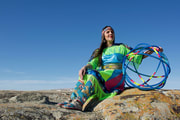|
On August 6, 2015 I was invited to the Pincher Creek Municipal Library to do a presentation for the summer storytelling program.
I choose to use dance and storytelling to share the Anishnaabe hoop dance story. I first learned this story almost ten years ago when I began hoop dancing. The full story along with many others can be found in Basil Johnston’s book The Manitous: The Spiritual Life of the Ojibway People. This story, like many First Nations stories, is timeless. The story is about Pukawiss, ‘the disowned one’, who was interested in creation and the natural world since he was a child. His father wished he would become a great hunter and warrior like his older brother, Maudjekawis. Pukawiss tried to be more like his brother, but would always return to his interest in nature and imitating animals around him. His father gave all his attention to his older brother and eventually Pukawiss became disowned and left his family. Pukawiss began to travel as a performer, dancer and choreographer becoming well known telling stories about life – love, hate, jealousy, etc. Eventually, he wanted to create a dance that showed all of life, the good and bad, so he created the hoop dance. Through the hoop dance we are taught about the struggles and triumphs in life. The beautiful designs reflect the beauty that is found all around us, such as birds, butterflies, flowers, etc. As the hoop dancer transitions from one shape to the next this shows that there are also struggles in life. The transition from one design to another also shows how everything in life is also interconnected, and the hoop itself represents interconnectedness, equality and balance. I think everyone can relate to Pukawiss’ journey and the burden of meeting the expectations of others. On a larger scale I think this story also shows the struggle of fitting into the roles that society and/or culture might assign to us. It is a powerful message for youth and young adults today to ‘be yourself’. Although, our skills, personality, or identity may not conform to the expectations that society and culture set forth we may find that we ‘fit in’ better when we are true to ourselves. I would like to dedicate this post to the memory and legacy of Basil Johnston who shared this story, and many others, in his books. Basil Johnston began his journey to the spirit world on September 8, 2015. He was a leader and inspiration with a profound knowledge of Anishnaabe culture, language and history. Miigwetch- Thank you! Photo Credit: Sally Turner, Pincher Creek Library
2 Comments
|
Nehiawsko Pikiskwew'Cree Woman Speaking' is a space to share my voice. My goal is to spread awareness and share wisdom as I learn and grow as a dancer, choreographer, and woman. My passion is to show the healing power of dance and culture. I love learning from elders, experience, and research and being able to synthesize Native and non-Native ways of knowing! Archives
November 2023
Categories
All
|
